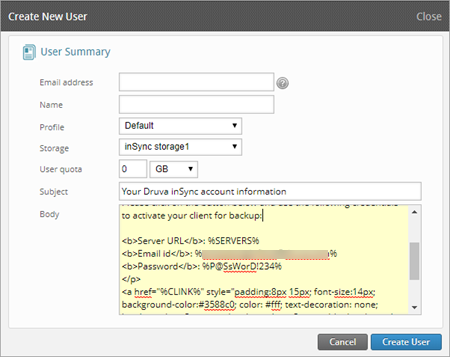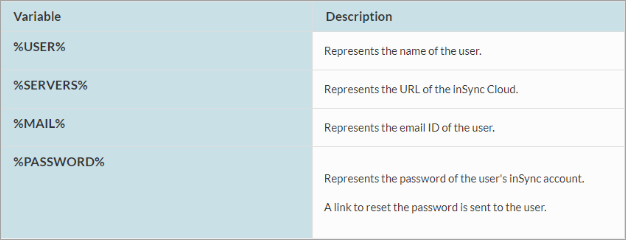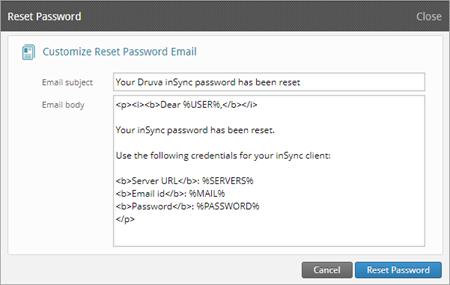How to customize the user activation and password reset emails
This article applies to:
- OS: All supported operating systems
- Product edition: inSync Cloud/On-Premise 5.X.X and later
Overview
This article describes how to make modifications to the New User or Password Reset Emails in inSync.
Change the New User email:
To change the New User email:
- On the inSync Management Console menu bar, click Users.
- Click Create New. The Create New User dialog box is displayed.
The default email message is displayed in the Body field of the dialog box. - Type your custom text in the Body field of the Create New User dialog box, without changing the following variables.
%USER%
%SERVERS%
%MAIL%
%PASSWORD%
%CLINK%
%SHAREMSG% -
You can go ahead and click Create User if you have added the required details on the Create New User dialog box.
For example, if the default content in the Body field is not up to the mark or if the administrator had configured this setting with a specific or incorrect value earlier (as displayed in the image below), incorrect details will get mailed to the new users who receive the activation email. This may result failure in client activation and user logins. Hence, administrators must ensure accurate details are included in the Body field of the email. You can use the below-mentioned content to reinstate the default mail content.

Default content: The default email text of the new user email is mentioned below. You can use this reference revert the modified content to the default email text.{code}
<p><i><b>Dear %USER%,</b></i>
This is an automated email from your Druva inSync administrator to enable your device for backup.
Please click on the button below and use the following credentials to activate your client for backup:
<b>Server URL</b>: %SERVERS%
<b>Email id</b>: %MAIL%
<b>Password</b>: %PASSWORD%
</p>
<a href="%CLINK%" style="padding:8px 15px; font-size:14px; background-color:#3588c0; color: #fff; text-decoration: none; border-radius: 3px; -moz-border-radius : 3px; -webkit-border-radius : 3px;">Download inSync Client</a>
<br />
%SHAREMSG%
{code}
Change the Password Reset email
Once the email account is configured, inSync administrator can customize the 'reset password email' content. inSync Server sends the updated content email to the user who requests for a new password.
To change the password reset email:
- On the inSync Management Console, click Users. The Manage Users page is displayed.
- Select the user for whom you want to modify the password reset email and then click More > Reset Passwrod.
The Reset Password dialog box is displayed. The default email message is displayed in the Email body field. - Type your custom text in the Email body field of the Reset Password dialog box without changing the following variables.
%USER%
%SERVERS%
%MAIL%
%PASSWORD%

-
You can go ahead and click Reset Password if you want to reset password.

The default email text of the password reset email is mentioned below. You can use this reference revert the modified content to the default email text.
<p><i><b>Dear %USER%,</b></i>
Your inSync password has been reset.
Use the following credentials for your inSync client:
<b>Server URL</b>: %SERVERS%
<b>Email id</b>: %MAIL%
<b>Password</b>: %PASSWORD%</p>
Note:
- The changes will be applied only if you create a user or reset the password for a user after making changes to the email body. You can perform these actions on a test user account.
- Once the modified email is sent to a user, the new modified email body becomes the default body for future emails.
- After customizing the email content, ensure you click Create User. Clicking on Close will not save the changes.
- Once you save the changes, refresh the browser to ensure the changes reflect in the Body of the password reset email.

